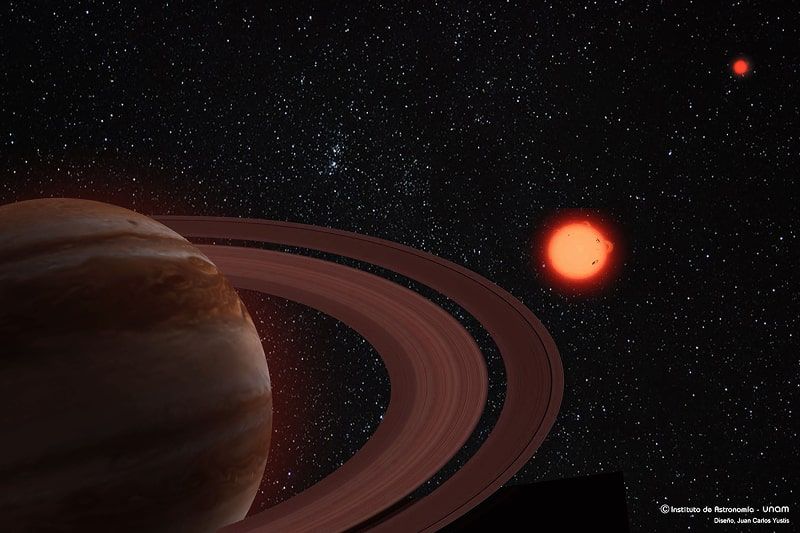Second exoplanet discovered using very high precision radio observations
It is a Jupiter-like planet orbiting a low-mass star. It was located with the technique of astrometry, which measures the position of the star. The finding was made possible with the VLBA radio telescope array, a system of ten identical antennas with a common central antenna.

For the second time, scientists from the Institute of Astronomy (IA) of the UNAM discovered an exoplanet (planet located outside our solar system) using very high precision radio observations made with the Very Long Baseline Array (VLBA), a system of 10 identical radio antennas, or radio telescopes, that are controlled by a common central station and work together from different parts of the world as a single instrument.
The VLBA, owned by the U.S. National Science Foundation, is operated by the National Radio Astronomy Observatory (NRAO) in Socorro, New Mexico. This interferometer is open to the astronomical community and can be used by groups around the world. The IA research team has been using it for decades to study star-forming regions, and now to search for exoplanets.
"It's a Jupiter-like planet, which is nothing new, but it's orbiting a very low-mass star, which is theoretically unlikely to exist, so it's special. Massive planets, like this one, are expected to form around solar-type stars but not around low-mass stars," explained Salvador Curiel Ramírez, a researcher at the Instituto de Astronomía (IA) and author of the study.
It is probably a gaseous planet. The technique used, called absolute astrometry and of a novel use for this type of discovery, can determine the orbit of the planet around the star and its mass, but not its density, which is necessary to determine if the planet is gaseous or rocky.
The planet is in a compact binary system, which created several problems for scientists because the nearby star is of very low mass, yet causes the star-planet system (with a separation similar to that of Venus and the Sun) to move at a very high speed around the center of mass of the binary system. "This complicates things in astrometry, since the separation of the two stars is very small, something like the distance between Neptune and the Sun," Curiel explained.
"However, by carrying out a simultaneous analysis of the orbital motion of the binary system and the orbital motion of the planet around the host star, we were able to establish the three-dimensional motion of the entire system, and the masses of both stars and the planet".
In turn, IA postdoctoral researcher and collaborator of the work, Gisela Ortiz León, recalled that this is the second detection of an exoplanet using radio astrometry.
"The method we use is astrometry, where what is measured is the position of the star at different times. When making these measurements, one observes over time that the star shows a small wobble, which gives away the presence of at least one planet," she explained.
The technique consists of measuring small variations in the position of the star with great precision, and for that, we need to use an instrument capable of achieving very high precision, such as the VLBA.
Curiel Ramírez added that to date more than five thousand exoplanets have been found, but this is the second one to be identified with radio telescopes using the astrometry technique. The observations with the VLBA allowed the indirect detection of a Jovian planet associated with a low-mass red star.
"Astrometry was the first technique used to search for planets, because it has been used for hundreds of years to locate the position of planets in the Solar System, and stars in general. Of course, the precision of the observations has been changing over time, and we are at a point where some instruments already give the precision we need to start looking for planets. We are just at that moment in which the technology, and the improvements that have been made to the instruments, already allow us to look for planets", he continued.
The scientist asserted that - thanks to the GAIA satellite that has been in orbit for about six years and the use of radio telescopes such as the VLBA and soon the ngVLA (next generation VLA) and SKA (Square Kilometer Array) - shortly astrometry will be among the first three techniques to search for exoplanets.
"With radio observations, we can observe stars that with optical and infrared is almost impossible. We are taking advantage of a window in which we are the only ones who can search for planets around this type of star that are young, very active, and with very intense magnetic fields, which means that techniques such as spectroscopy and transit are very affected in the measurements," he remarked.
"On the other hand, the younger the star is, the more intense the magnetic field and the more active the star is, the more radio emissions it has," he specified. In the work, published in The Astronomical Journal, two other scientists participated with Curiel Ramírez and Ortiz León: Joel Sánchez Bermúdez, IA researcher; and Amy J. Mioduszewski, from the NRAO of the United States. Available at: https://arxiv.org/abs/2208.14553.




